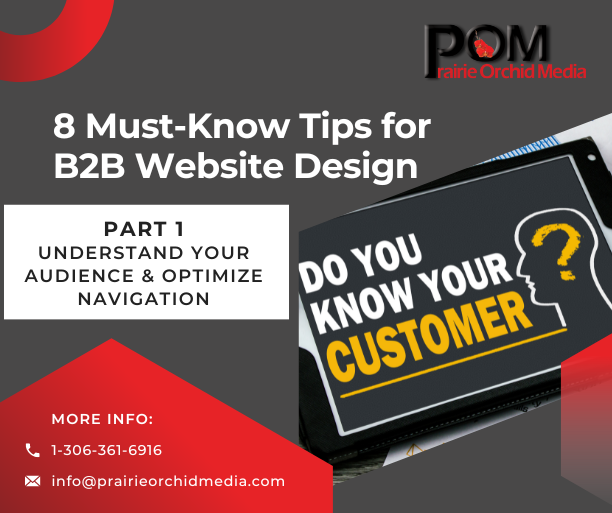As a business owner, you know how important an online presence is. Having a website that stands out and captures your customers’ attention is essential for success in today’s digital world. But the development of a successful B2B website can seem like an overwhelming task. Don’t worry! We’re here to make things easier for you with 8 must-know tips for website design and SEO.
Exploring website layout, search engine optimization, and various online marketing methods will help you make your website into a business asset. We'll show you why website design is a key investment strategy for businesses looking to expand online.
What's B2B Website Design?
B2B is short for Business to Business. It refers to a type of business that does not sell directly to consumers. Instead, it sells its products or services to other businesses. B2B companies have their own unique set of needs. Why are small business websites important? Small businesses are the backbone of our economy.
Website design is all about creating an attractive and user-friendly virtual environment for your customers. It involves everything from choosing the right colors and fonts to optimizing images and layouts for maximum impact. But it's not just about looks - a great website also needs to be functional, easy to navigate, and optimized for search engines like Google. That's where SEO comes in. By optimizing your site with relevant keywords, meta tags, and other tactics, you can improve your visibility on search engine results pages (SERPs) and attract more traffic to your site. We're about to dive into the wonderful world of B2B website design! If you don't know what that is, don't worry. We'll break it down for you.
Tip #1: Understand Your Audience
The first and foremost thing you need to do is understand your audience. It might sound like a no-brainer, but trust us, it's easier said than done! You don't want to design a website that looks like a unicorn threw up all over it, leaving your potential clients confused and lost. That's why understanding your audience is crucial for successful website development. For instance, if the majority of your clients are over 60, don't go with a bright and flashy design that's meant for millennials!
 When we talk about understanding your audience, we don't just mean knowing their age, gender, and location. Those are important factors too but in the digital world of SEO and website design, you need to go deeper than that. What are their pain points? What kind of problems do they want solved by using your services? Who are you trying to reach? What do they care about? What's most important to them? These questions can help you decide what type of website design your company needs. Then, we'll be able to understand how to design a site that will be most attractive and effective for your audience. Knowing the answers to these questions can help you create content that resonates with them.
When we talk about understanding your audience, we don't just mean knowing their age, gender, and location. Those are important factors too but in the digital world of SEO and website design, you need to go deeper than that. What are their pain points? What kind of problems do they want solved by using your services? Who are you trying to reach? What do they care about? What's most important to them? These questions can help you decide what type of website design your company needs. Then, we'll be able to understand how to design a site that will be most attractive and effective for your audience. Knowing the answers to these questions can help you create content that resonates with them.
The great thing about a content-first approach is that it enables us to build an organic website that will attract your audience and produce results for your business. Research will help you understand how to design a site that is most attractive and effective for your audience.
If you don’t know who your audience is and how they use the web, then you can’t design a site that speaks to them. A content-first approach can help you create content that resonates with them. As you begin this process, don t be afraid to ask for help. If you are unsure about what to write or how to approach your audience, consider seeking the advice of a professional copywriter who is familiar with your business and its goals. You can also ask for help from friends or other people who are familiar with your business. As you write your content, think about how you want the experience to feel for your audience. Are you trying to inform them? Are you trying to sell them on a specific product or service?
Tip #2: Optimize Navigation
When it comes to website development, design is paramount. But what good is a visually stunning website if your users can't navigate it with ease? That's where optimizing your navigation comes in handy. Not only does it improve user experience, but it also boosts your SEO ranking and helps attract more B2B clients.
-
Keep Your Menu Simple
First things first, simplify your menu bar. Keep the categories broad and intuitive so users can easily find what they're looking for without getting lost in a maze of subcategories. Use clear and concise language for each tab - no need to get fancy here! And don't forget about mobile responsiveness - make sure your menu bar collapses into an easy-to-use dropdown on smaller screens. Too many options can overwhelm visitors, leading them to abandon ship before they even get a chance to explore what you have to offer. -
Make Content Intuitive
 Just because you're an expert in your business doesn't mean everyone else is, too. If you're having trouble finding information on your own website, why would a potential client want to? When designing your website, make it easy for visitors to find what they're looking for. Try using clear and concise language to describe what you do and how you can help them. Don't hide behind jargon or unnecessarily complicated language - the simpler, the better! If you're having trouble finding information on your own website, why would a potential client want to? When designing your website, make it easy for visitors to find what they're looking for. Try using clear and concise language to describe what you do and how you can help them.
Just because you're an expert in your business doesn't mean everyone else is, too. If you're having trouble finding information on your own website, why would a potential client want to? When designing your website, make it easy for visitors to find what they're looking for. Try using clear and concise language to describe what you do and how you can help them. Don't hide behind jargon or unnecessarily complicated language - the simpler, the better! If you're having trouble finding information on your own website, why would a potential client want to? When designing your website, make it easy for visitors to find what they're looking for. Try using clear and concise language to describe what you do and how you can help them. -
Add a Search Bar
Next up, consider adding a search bar to your site. This feature allows users to quickly find what they need without going through multiple pages or tabs. Should you choose to include one on your site, make sure that it's easy for visitors to use. You want them to be able to find what they're looking for in a matter of seconds! -
Organize Your Content
To optimize the user experience on your website, organize categories logically, so that your users will be more able to find what they're seeking quickly and easily without needing to struggle with a maze of links. In your content, be sure to optimize for mobile devices. This is just one more way that you can boost ROI on your website and increase traffic from visitors. If you have a blog, then it's vital that you optimize it for the search engines. By making sure that your posts are relevant and well-written, you'll be able to attract more visitors to your site, who will then be likely to buy or convert on your product or service.
Make sure your categories are logically grouped together so that users can quickly find what they're looking for without having to dig through a maze of links. Your categories should be front and center, easy to navigate and clear in their purpose. Don't make your users dig through layers of menus just to find what they're looking for - ain't nobody got time for that! And don't forget about mobile optimization - with more and more people accessing websites on their phones, it's important that your navigation is just as user-friendly on smaller screens.
But it's not just about making life easier for your users. Organizing categories logically can also work wonders for SEO. -
Include Contact Info
 Finally, don't forget to include your contact information. Having a phone number and email address on your site is critical for connecting with potential clients. Without it, it will be much more difficult for you to grow your business.
Finally, don't forget to include your contact information. Having a phone number and email address on your site is critical for connecting with potential clients. Without it, it will be much more difficult for you to grow your business.
Not only does having contact information improve communication, but it also boosts your SEO (search engine optimization) game. Search engines like Google love websites that are easy to navigate and have clear calls-to-action (CTAs). By including your contact information, you're making it easier for search engines to crawl through your site and index important pages. Plus, having a phone number displayed prominently on your site shows that you're open for business – B2B clients will definitely appreciate this!
There's a lot to consider when it comes to creating an awesome B2B website! You've gotta think about your audience, optimize your navigation - all the important stuff! Applying our B2B web design tips can help make sure that your website impresses customers and shimmers in comparison to all of the competition. While these tips can be daunting, we hope that they're helpful to you when it comes to creating an awesome B2B website! If you'd like to learn more, check out the rest of our blog. We've got tons of valuable articles on website design, SEO and content creation!
Tune in next week when we'll reveal two additional tips - don't miss out!
Thanks for being part of the Prairie Orchid Media community, and we look forward to helping you reach your website goals this year. We offer a wide range of web development and design services to help businesses increase their web presence.



